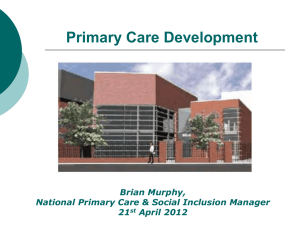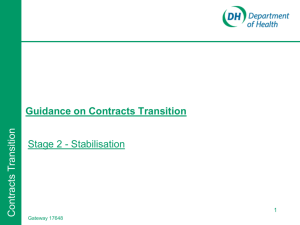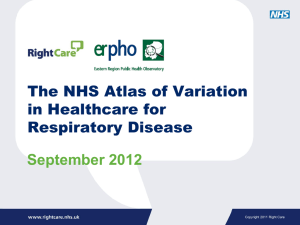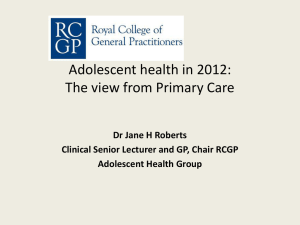Practice Managers Meeting - HSE 2011
advertisement
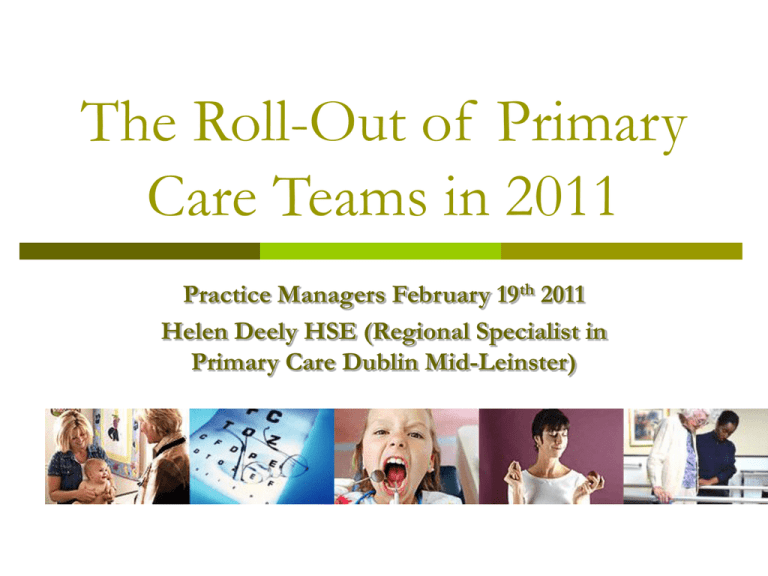
The Roll-Out of Primary Care Teams in 2011 Practice Managers February 19th 2011 Helen Deely HSE (Regional Specialist in Primary Care Dublin Mid-Leinster) Primary Care Health Strategy 2001 Primary Care Strategy Primary Care - 90 – 95% of all health and social needs Secondary Care – complex and special needs Central focus of the health system Team based approach to health service provision. Shift appropriate activity from hospitals Why develop a Primary Care Team? Information and Service Flow in the past - Non Integrated Local Service PHN Information and Service Flow now - Integrated Primary Care Team GP Phy Phy PHN GP SW OT OT Direct Referral Referral Service Feedback SW Direct Referral and Feedback Formation of PCT’s guided by the following requirements: To maximise coverage for 100% of population To ensure ease of access to services and simplify communication and referral processes To support epidemiological population health monitoring, especially health inequalities To facilitate community involvement in need assessment To support evidence based decision making To support future management and governance arrangements within HSE. To facilitate team working amongst health professionals including GPs Who’s involved in Primary Care? Establishing the Team GP Practice nurse Practice staff Reconfigure existing staff: PHN RGN Clerical Admin Primary Care Team Additional staff: Physiotherapy Occupational Therapy Social Worker Network Services & Linkages Integrated Services PCT ‘A’ • Counselling • Local Multi Agencies • Child Protection Hospitals • Orthodontics PCT ‘E’ PCT ‘B’ • Area • Private Providers • Voluntary • Psychiatry PCT ‘D’ PCT ‘C’ • Dietetics • Support Groups • Specialist • Home Help • Other • Alternative Care Each Primary Care Team is planned to be part of a wider network known as the Health & Social Care Network. Health & Social Care Network Services Audiology Services Psychology / Counselling Services Podiatry Services Community Health Medical Services (Area Medical Officers) Community Welfare Services Dental Services Dietetic Services Ophthalmology Services Environmental Health Services Civil Registration Services Community Development Services Carers Services Where we came from? Survey undertaken (August 2008) involving GPs and Public Health Nurses who were not in Primary Care Teams determined that: 20% of GPs and PHN never had face-to-face contact 29% of GPs indicated that they did not know the PHNs by name 97% of GPs and 81% of PHNs had no working email address for each other 56% of GPs and 77% of PHNs did not have each others mobile phone number Although 45% of GPs and PHNs were in weekly phone contact, as many 1 in 25 (4%) reported contact on less than an annual basis. PCTs provide multidisciplinary care, which was previously provided in a unidisciplinary manner prior to the establishment of Teams. Aim of the Primary Care Team To provide Primary Care Services that are: Accessible Anyone who lives in the team geographic area Service users can self-refer High Quality: Care planning Service planning Continuous education Meet the needs of the local population Liaison with local community Needs assessment Once off needs & chronic complex needs What do PCTs do? First point of contact Defined set of core community-based services individual care plans for patients with chronic illness or other complex needs. Link with other community-based professionals such as mental health. Integrate with acute hospital services - reduce hospital admissions, early discharge of patients and chronic disease management programmes. Clinical Team meetings Central to Team functioning Feedback from GPs highly positive Business like fashion – agendas, list of patients etc circulated in advance Leadership within Team required – TDOs facilitated work to date. Acknowledged there is a myriad of contacts outside of CTMs. Supporting systems required – Admin and governance Variances apparent – need to identify reasons and solutions CTM Variances Of the 246 Teams that held Clinical Team meetings held in September: 71% of Teams held 1 CTM (175 PCTs) 21% of Teams held 2 CTMs (52 PCTs) 5% of Teams held 3 CTMs (13 PCTs) 2% of Teams held 4 CTMs (6 PCTs) 11% PCTs held no CTM in month 23% had CTMs without GPs 5% 2% 1 21% 2 3 4 72% PCT Challenges Change from traditional linear working to multi-disciplinary Different roles & personality differences Contractual differences Leadership issues For Teams to work well they must be properly resourced – staff, skills, training, information, equipments, access to specialists etc Challenges cont… CHANGE!! Becoming a team Recruitment & non replacement of staff Capacity: cradle to grave; health & social services Boundaries Accommodation Clinical audit : patient pathways Lack of systems to record how much we do/how well we do it/ how much it costs us to do it IT: no single patient record, no secure email GP Engagement Locally through the TDO Estates for PPPs Primary Care Support Doctors – local & national forums Exploration of CME Credits for education element of CTMs (not agreed). Joint initiatives to engage GPs Business like approach to Mtgs – prove the benefits. Example of PCT initiatives Dietitian Clinic & shared Care diabetes Smoking Cessation Falls Prevention Groups Incredible years Antenatal clinics Reduction in outpatient appointments physio/dietetics clinics, etc. Joint discharge planning between acute & Primary Care Pharmacy engagement Infrastructure PPP progress has been slower than anticipated in 2010 due to the funding difficulties by developers HSE Board approved 210 locations under the PPP initiative. HSE has signed 12 lease agreements, 23 Agreements to Lease and 82 letters of intent. 12 locations have been completed within the past 12 months accommodating 17 PCTs A further 42 have been identified to be completed in 2011 By 2013 - 115 PCCs operational supported by 160 PCTs Integrated Working with Acute Essential that Acute and Primary Care Services are a seamless service – PCT first point of contact with patient Acute Hospital Service Post Admission Chronic Disease Management Shift from episodic acute hospital care integrated care focused on primary care. Hospital Integration Discharge planning Shared care – diabetes, asthma Current hospital care to be provided in the community e.g. cancer initiative, minor surgery Access to Diagnostics OPD direct access to hospital Primary Care Team Development Target to have 527 Teams in place by end of 2011 Plan to create 134 Health and Social Care Networks Steps to Primary Care Development… Step 1 – Develop PCTs Foundations (complete by end 2011) Step 2 – Strengthen functionality of Teams Identify and address staffing deficits Strengthen team working though training or otherwise Implement standard business processes Complete health needs assessment & strengthen community participation Hold regular CTMs with log of care plans Steps to PC Development…(cont’d) Step 3 – Development of Network Services Implementation of governance and management structures. Alignment of specialist and care group services. Implementation of general principles of referral and shared care arrangements with secondary care, care group and specialist services. Step 4 - Develop health promotion and proactive services within the team Roll out of Chronic Disease Management Falls prevention programmes Locally targeted programmes Supporting Developments Management and Clinical Governance ICT Chronic Disease Management Community Needs Assessments – guidance doc nearing completion Reconfiguration of Admin staff Plan Resource Pack for PCTs DVD Community Engagement Guidelines Pharmaceutical Engagement Guidelines (draft) Primary Care Performance Activity 350 Teams in operation at end of December 2010 (89% of 2010 target) Additional 31 Teams holding multi-disciplinary clinical meetings between HSE staff without GPs 2,615 Staff assigned to functioning Teams Over 1,309 GPs participating on Teams Primary Care Performance Activity & Performance Indicators cont… ICT Supports – Hardware requirements, work with GPIT group to progress secure e-mail Enhancement of Primary Care Services – Community Intervention Teams IV Therapy Falls Prevention CMHTs Smoking cessation Breast feeding training for PHNs Prescribing (QCCD) – cost effective prescribing choices Primary Care Performance Activity & Performance Indicators cont… Cancer Services training for practice nurses in cancer prevention care, community nurse education programme further developed, information/training sessions for GPs and electronic referral cancer systems developed within the GP software packages Chronic Disease Management (QCCD) – Commencement of Clinical Leadership for primary care & Guidelines for disease management for 7 priority programmes pertinent to Primary Care – Stroke Heart Failure Asthma Diabetes COPD Dermatology/Rheumatology Care of the Elderly Chronic Disease Management in Primary Care Most of the care of patients with chronic conditions takes places within the primary healthcare sector. This includes: Diagnosis, treatment and rehabilitation of patients with chronic conditions; Early detection, assessment and follow-up comprehensive medical treatment Preventive activities including smoking cessation, dietary advise and support of patients’ self care. Estimated 15-16 million consultations in general practice while approximately 1.9 million consultations take place in out-patient departments each year. Why focus on Chronic Disease 80% of GP consultations 60% of hospital bed days 2/3rds of emergency medical admissions to hospitals. 8 of the top 11 causes of hospital admissions are due to chronic diseases 5% of inpatients with a long-term condition account for 42% of all acute bed days. CDMP - 50% reduction in unplanned hospital admissions as well as a 50% reduction in bed day rates Falls Prevention 34,000 treated per year due to falls = 703,000 bed days Hip fractures – €35m per year 2 out of 3 over 65 who fracture hip never return home Falls Prevention PCT delivered >25 PCT’s delivering Fall Programmes Programmes reduce falls by 15 – 30 % Potential savings: €17.5 m Diabetes 10% total healthcare budget -700m per year Complications of DM cost €696m per year 4.1% reduction in Stroke/ MI in a 3 year structured DM programme Heart Failure A structured shared care model between Primary Care/ Hospital would prevent: > 4,000 hospitalisations per year free up 50,000 bed days. Equivalent to building a small to medium size hospital at a cost of €27m. Asthma 5,000 admissions per annum Structured Primary Care Model (Finland) 54% reduction in hospital bed days 90% reduction in deaths COPD Estimated by 2020 COPD will be third leading cause of death worldwide. 2003 - COPD caused 4.9% of all deaths in the UK At least 10% of emergency admissions to hospital are COPD related Average hospital stay of nine days per exacerbation, three to four times a year Integrated care intevertion including education, coordination among levels of care and improved accessibility, reduced hospital readmissions in COPD after 1 year. Stroke Rates in Irish Population Stroke/TIA Hospital Bed Use Stroke: 1.93/1,000 pop. (NDPSS)/ TIA: 0.62/1,000 pop. (NDPSS) 10,817 new stroke/TIA nationally per year- 1 every hour 9,570 hospital admissions/yr (2000-06, HIPE) Stroke/TIA Combined: 5% of all hospital bed days (HIPE, 2000-06) Estimated 2009 Total Direct Costs - €405m Atrial fibrillation Atrial fibrillation (irregular heartbeat) in 10-20% of over-70s Extensive brain injury disability, NH care common 30% of all stroke (NDPSS, INASC) Easy and inexpensive to detect (pulse, ECG) 70% preventable (blood-thinning anticoagulation) Only 25% of known AF treated (NDPSS) 600 missed opportunities - potentially-preventable severe strokes in 2006 Benefits of Primary Care Team Improved service to the client Safer more co-ordinated care Clearly identifiable for patients Named Nurses, physiotherapists, occupational therapists, social worker on the team, relationship building Shorter waiting times for Occupational Therapy, Physiotherapy, Social Work Range of services provided increased Increased clinical contacts with clinical rooms Single referral form/self referral More focus on: health promotion disease prevention Improved communication and information sharing Communication with other agencies e.g. hospitals, voluntary groups and community groups Benefits to staff: high staff retention levels Benefits of PCTs cont… Local personal relationships with clients/patients Community-based services near patients’ home Better use of the clinical skills of the various professionals; Identify and tackle critical local health issues e.g. suicide prevention; Less duplication and fragmentation in the health system due to better communication structures; Decrease hospital attendance through the delivery of chronic disease management programmes Transfer services from acute hospitals to the community e.g. diagnostics, minor surgery, wound management, IV therapy in the community; Facilitate early discharge through the delivery of CITs, pre-hospital and discharge planning, timely access to appropriate multi-disciplinary services in the PCTs; Support patients in the community e.g. falls prevention programme; Offer multidisciplinary health promotion initiatives De-stigmatise the provision of Mental Health services in the community In complex cases a Key Worker navigates health system on behalf of the patient Feedback on Development to date….. Lack of Resources: Those teams without premises feel very strongly about this position and feel they will not work as a “team” until this is rectified. The moratorium is leaving teams without resources and this has been identified as a key risk in a number of teams. Lack of basic IT equipment coupled with no administrative support is impinging on team effectiveness. Next Steps… Continue roll out of PCTs Staff reconfiguration Engagement with GPs Strengthen exiting Primary Care Teams Implementation of governance arrangements Strengthen team working though training or otherwise Implement standard business processes Complete health needs assessment Primary Care Centre Developments Development of Performance Metrics PCT Needs Assessments Progress Engagement with Acute Develop Health and Social Care Networks Roll out of Chronic Disease Management Programmes Updated and clear information needs to be communicated to the public, PCT members, and HSE literature and websites. We know Patients feel they get a better service from a multi-disciplinary team Staff are happier working in well functioning teams Happier staff deliver better services Countries with advanced health systems are moving to this way of working Discussion….
